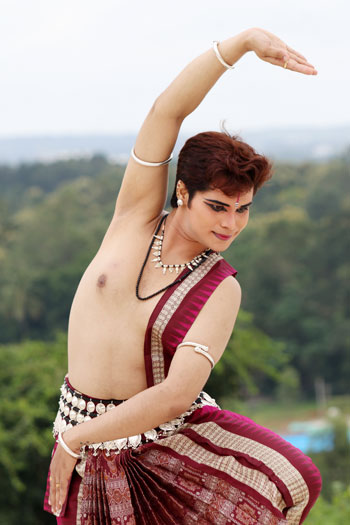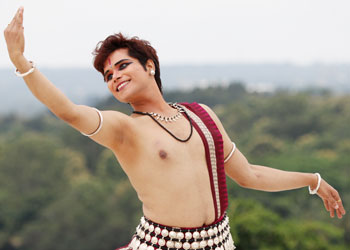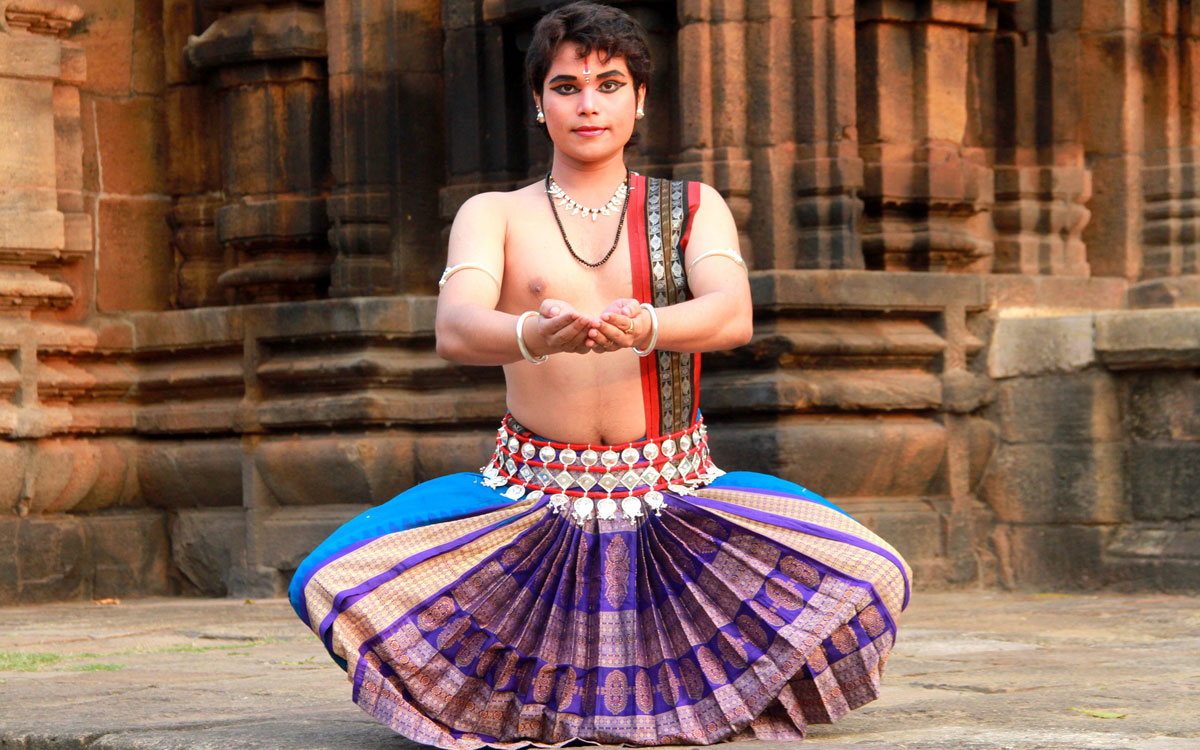Debasish Patnaik “Male Dancers Can Perform Odissi Quite Well”
How and when did you get initiated to dance?
“In 1992 when I saw the video of “Tu cheez badi hai Mast Mast” song in television, which aroused a spark in me to start learning dance, then I learned the particular song and got first prize in various dance competitions. Then one of my aunt named Susama she advised me to learn Odissi, observing my body movements and dancing style. its in the year 1993 i joined Odissi dance class without informing of my parents under first guru Late Guru Sri Kashinath Roul. then in the year 2002 I joined Guru Sri Durga Charan Ranbir for intensive Odissi learning and continuing to learn with his guidance I am lucky to learn Odissi from such a prominent guru. this is how my journey of Odissi commenced”.
 Do you belong to a traditional family of musicians or dancers?
Do you belong to a traditional family of musicians or dancers?
“No, in the whole family i am the only dancer that too a male dancer. In college days my father used to sing songs and has won lots of appreciation in terms of prizes and felicitation. And my mother was involved with theater in her college days. . For me this was one of the hardest part, at the start of my journey”.
Is dance hereditary or your personal choice?
Being a Dancer is completely my personal choice.
What is the Gotipua tradition? Its relevance to the contemporary society?
Gotipua, is a majestic folk dance of Odisha, it speaks about one of the ancient Indian Classical dance culture i.e. Most probably the beautiful attribute or the aspect of this dance tradition where the boys disguise themselves as females and perform to praise Lord Jagannath”.
In Oriya language, “Goti” means “single” and “Pua” means “boy”. In ancient times, the temples of Orissa had female dancers called “Devadasi or Mahari” (in Orissa) who were devoted to Lord Jagannath. The sculptures of the dancers on the famous temples of Orissa (the Sun Temple in Konark and the Jagannath temple in Puri), show the evidence of this very ancient tradition.
Around the 16th century, with the decline of the Mahari dancers, the class of these boy dancers came into existence in Orissa, to carry out the tradition. This was during the time of Bhoi king Rama Chandra Dev, founder of Bhoi dynasty. The Gotipua dance is in Odissi style, but their technique, costumes and presentation differ from those of the Mahari. The singing is done by the dancers themselves.
It is largely from the Gotipua dance that the present form of Odissi dance has evolved. Most of the present-day Gurus of Odissi dance (like the famous Guru Kelucharan Mohapatra from Raghurajpur village) were Gotipua in their young days.
The captivating style of Odissi dance is based in tandava (vigorous, masculine) and lasya (graceful, feminine) dance, and has two basic postures:
”Tribhangi” where the body is held with three bends of the head, torso and knees,
”Chouka”, a square – like stance that symbolizes Lord Jagannath.
The fluidity of the upper torso is characteristic for Odissi, and is often compared to the gentle waves of the sea that forever caress the Orissa beaches.
Odissi is lasya dominated, did you experience any difficulty in maintaining its elegance and lyrical quality?
Odissi is not lasya dominated, as i follow Guru Deba Prasad Das dance style in which u can have both faminine and masculine style of dance. It is upto you which dance style u choose. that iswhy it was not that difficult for me to maintain its elegance and lyrical quality., along with the vibrancy and vitality”
The perspective of male dancers, what has been your experience?
In India especially in Odisha its a taboo to become a male dancer. Parents wants their male child to become a working professional like engineer or doctor. In this condition it was very hard to convince them to allow me to dance, l. I had to convince my parents which was literally impossible then I attempted suicide as my parents were not allowing me to dance, after this incident they become serious about my passion and allowed me to dance. In this way I have struggled a lot during my journey to make an identity in this field. “
Your experience with your mentors?
I carry wonderful experience with mentors not only learning dance, in regards to polishing my attitude, personality, presentation skills and all round development as a fine human being.
The difference of styles of Pankaj Charan Das or Kelubabu, your comment?
I believe Odissi is one. There are two types of bhangi “Tribhangi” & “Chouka” it’s depends on the gurus which bhangi they give more preference. According to me rice is one it’s the chef who decides what to make out of it, biryani, pullao, lemon rice or bisi bhat Etc.
Your experience both in India and abroad?
I have acquired quite a lotl of experience in India and abroad performing in 39 countries. In India in terms of performance I have performed in almost near to all major dance festivals. I stood 1st consecutively for 2 years in Odisha Inter college dance competition. In the year 2002 after I finished my HSC, for higher studies in the field of Odissi I went to Bhubaneswar and joined Nrutyayana under my present Guru Sri Durga Charan Ranbir, then on 2003 I performed in Konark Festival with my guru’s group I got noticed by that performance Then in 2004 along with my dance I successfully completed my 12th exam (P.U).
 Its 2007 which plays a major milestone in my journey when I completed Graduation in Arts and I received “Shingar Mani” Title from former President of India Dr. Pratibha Patil and in this year for the very 1st time I performed in Singapore, Malaysia, Thailand, Jakarta, Java, Sumatra & Mauritius, then in the year 2008 when I paved a milestone in my journey with my Gold Medal in Master Degree (Nrutyabhaskar) in Odissi from Pracheen Kala Kendra Chandigarh & again I visited South korea, Japan, Taiwan, In the same year on my parents wedding anniversary i started my own Dance Company Debnrutyam Studio then in 2009 I visited Russia, Uzbekistan, Kazakhstan, Tashkent, Israel & again in the year 2010 I Performed in various places in Japan like Fukuoka, Tokyo, South Korea.
Its 2007 which plays a major milestone in my journey when I completed Graduation in Arts and I received “Shingar Mani” Title from former President of India Dr. Pratibha Patil and in this year for the very 1st time I performed in Singapore, Malaysia, Thailand, Jakarta, Java, Sumatra & Mauritius, then in the year 2008 when I paved a milestone in my journey with my Gold Medal in Master Degree (Nrutyabhaskar) in Odissi from Pracheen Kala Kendra Chandigarh & again I visited South korea, Japan, Taiwan, In the same year on my parents wedding anniversary i started my own Dance Company Debnrutyam Studio then in 2009 I visited Russia, Uzbekistan, Kazakhstan, Tashkent, Israel & again in the year 2010 I Performed in various places in Japan like Fukuoka, Tokyo, South Korea.
Every Year I organize lots of Programs in Rourkela, Odisha and in Bangalore like Nartakah (A male Indian Classical Dance Fest), Rudra Dhara & Smruti Sradhanjali Festival, Rasa Rangini and Odissi Sandhya. In the year 2015 i opened a branch of Debnrutyam Studio in Bannerghatta Road, Hulimavu, and Bangalore. Then in the year 2016 I got Junior Fellowship award under Ministry Of culture govt of India, in the same year I become Empanelled artist of “ICCR” & “Festival of India” by Ministry of Culture Govt of India.
Which role is more important and why, Dancer, teacher, choreographer or organizer?
As a dancer for me Dancer role is more important, as its your performances that would establish you as a fine exponent”
Your future plan or aspirations?
To popularize my dance style globally. Spread the knowledge and aesthetic beauty of odissi to more and more people in terms of openings multiple branches of my dance academy Debnrutyam Studio (R) across globe. And to come up with my unique masterpiece recitals with my own recordings.


